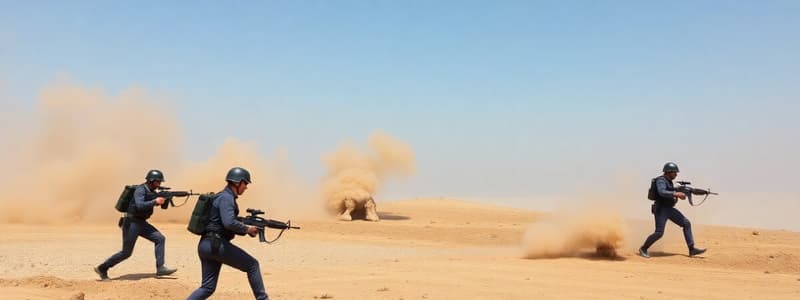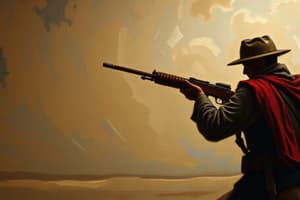Podcast
Questions and Answers
What must occur before the UNSC can authorize the use of force under collective security?
What must occur before the UNSC can authorize the use of force under collective security?
- A military alliance must be formed
- All peaceful means must be tried and failed (correct)
- A global consensus must be reached
- The affected state must agree to it
Under Article 51 of the UN Charter, what constitutes an armed attack?
Under Article 51 of the UN Charter, what constitutes an armed attack?
- Mere incidents at the border that escalate into conflict
- Action by regular armed forces across an international border (correct)
- Provision of support to internal rebel groups
- Threatening another State without physical violence
Which article of the UN Charter specifies the steps the Security Council can take when it finds a threat to peace?
Which article of the UN Charter specifies the steps the Security Council can take when it finds a threat to peace?
- Article 39 (correct)
- Article 41
- Article 30
- Article 12
According to the definition adopted by General Assembly Resolution 3314, which of the following describes aggression?
According to the definition adopted by General Assembly Resolution 3314, which of the following describes aggression?
What principle must be established after confirming the necessity of using force, according to the Oil Platforms case?
What principle must be established after confirming the necessity of using force, according to the Oil Platforms case?
What is a significant factor that differentiates mere frontier incidents from armed attacks?
What is a significant factor that differentiates mere frontier incidents from armed attacks?
What happens while the Security Council is considering a peaceful settlement of disputes?
What happens while the Security Council is considering a peaceful settlement of disputes?
What did the US claim as justification for its military activities against Nicaragua in the 1980s?
What did the US claim as justification for its military activities against Nicaragua in the 1980s?
How is assistance to rebels typically classified under international law?
How is assistance to rebels typically classified under international law?
Under which chapter of the UN Charter does collective security action fall?
Under which chapter of the UN Charter does collective security action fall?
In the context of the Nicaragua case, what constituted an 'armed attack'?
In the context of the Nicaragua case, what constituted an 'armed attack'?
What role does the UNSC play under Chapter VII of the UNC?
What role does the UNSC play under Chapter VII of the UNC?
Which article of the UN Charter discusses the right to self-defense?
Which article of the UN Charter discusses the right to self-defense?
What was determined about Nicaragua's support for the Marxist guerilla group in El Salvador?
What was determined about Nicaragua's support for the Marxist guerilla group in El Salvador?
What limits the right to self-defense under international law?
What limits the right to self-defense under international law?
Which military activities by the US against Nicaragua were deemed illegal?
Which military activities by the US against Nicaragua were deemed illegal?
What type of measures can the Security Council recommend or decide upon according to Article 41?
What type of measures can the Security Council recommend or decide upon according to Article 41?
What was a key feature of the justification for US military involvement in Nicaragua?
What was a key feature of the justification for US military involvement in Nicaragua?
Which of the following is NOT a condition the UNSC must find to act under collective security?
Which of the following is NOT a condition the UNSC must find to act under collective security?
What was the reasoning behind the claim of collective self-defense by the US during its military activities against Nicaragua?
What was the reasoning behind the claim of collective self-defense by the US during its military activities against Nicaragua?
What is a major difference between 'use of force' and 'armed attack' as demonstrated in the Nicaragua case?
What is a major difference between 'use of force' and 'armed attack' as demonstrated in the Nicaragua case?
What did the court determine regarding the US's military actions in Nicaragua from 1983 to 1984?
What did the court determine regarding the US's military actions in Nicaragua from 1983 to 1984?
Which justification was rejected by the court for the US military activities in Nicaragua?
Which justification was rejected by the court for the US military activities in Nicaragua?
What specific obligation did the US breach when its aircraft flew over Nicaraguan territory?
What specific obligation did the US breach when its aircraft flew over Nicaraguan territory?
How did the ICJ define 'armed attack' in the context of the Nicaragua case?
How did the ICJ define 'armed attack' in the context of the Nicaragua case?
In what way did the US intervene in Nicaragua's domestic affairs according to the court?
In what way did the US intervene in Nicaragua's domestic affairs according to the court?
What was one of the actions that resulted in a breach of customary international law by the US in Nicaragua?
What was one of the actions that resulted in a breach of customary international law by the US in Nicaragua?
Which of the following was NOT a ground for breaching international law by the US as per the ruling?
Which of the following was NOT a ground for breaching international law by the US as per the ruling?
What threshold did the ICJ find necessary for an action to be defined as an 'armed attack'?
What threshold did the ICJ find necessary for an action to be defined as an 'armed attack'?
What major shift does the Responsibility to Protect (R2P) represent in terms of state sovereignty?
What major shift does the Responsibility to Protect (R2P) represent in terms of state sovereignty?
Which document outlines the three pillars of the Responsibility to Protect?
Which document outlines the three pillars of the Responsibility to Protect?
Under the Responsibility to Protect, what is one of the obligations of each state?
Under the Responsibility to Protect, what is one of the obligations of each state?
In the context of armed conflicts, what is necessary for the acts of armed groups to be attributed to another state?
In the context of armed conflicts, what is necessary for the acts of armed groups to be attributed to another state?
Which of the following describes a limitation of the Responsibility to Protect?
Which of the following describes a limitation of the Responsibility to Protect?
What does Article 51 of the UN Charter pertain to regarding state actions?
What does Article 51 of the UN Charter pertain to regarding state actions?
What is meant by 'timely and decisive response' in relation to R2P?
What is meant by 'timely and decisive response' in relation to R2P?
Which of the following best describes the nature of the Responsibility to Protect?
Which of the following best describes the nature of the Responsibility to Protect?
What was the primary concept introduced by the Kellog-Briand Pact?
What was the primary concept introduced by the Kellog-Briand Pact?
Which article of the UN Charter specifically prohibits the use of force against the territorial integrity of states?
Which article of the UN Charter specifically prohibits the use of force against the territorial integrity of states?
What defines 'individual self-defense' in the context of the use of force?
What defines 'individual self-defense' in the context of the use of force?
What requirement must be met for collective self-defense to occur?
What requirement must be met for collective self-defense to occur?
According to Thomas Aquinas's 'Just War Theory,' which aspect is critical for waging war?
According to Thomas Aquinas's 'Just War Theory,' which aspect is critical for waging war?
What major change occurred post-2003 regarding the concept of sovereignty?
What major change occurred post-2003 regarding the concept of sovereignty?
What are the two limitations established during the 1907 Hague Peace Conference?
What are the two limitations established during the 1907 Hague Peace Conference?
What principle did the US Secretary of State emphasize regarding anticipatory self-defense?
What principle did the US Secretary of State emphasize regarding anticipatory self-defense?
What was a key message in the Preamble of the UN Charter?
What was a key message in the Preamble of the UN Charter?
How did the era before the 20th century view war?
How did the era before the 20th century view war?
Flashcards
Armed Attack (International Law)
Armed Attack (International Law)
An attack by a state against another state, involving the use of military force, that reaches a certain threshold of gravity, typically involving significant and sustained military operations.
Necessary and Proportional (Self-Defense)
Necessary and Proportional (Self-Defense)
A state can use force in self-defense only if it is "necessary" and "proportional" to the threat.
Necessity (Self-Defense)
Necessity (Self-Defense)
A state's use of force against another state must be necessary to protect itself from an imminent threat.
Proportionality (Self-Defense)
Proportionality (Self-Defense)
Signup and view all the flashcards
Non-Intervention
Non-Intervention
Signup and view all the flashcards
Prohibition on the Use of Force
Prohibition on the Use of Force
Signup and view all the flashcards
Collective Self-Defense
Collective Self-Defense
Signup and view all the flashcards
Right to Collective Self-Defense
Right to Collective Self-Defense
Signup and view all the flashcards
Era 1: Pre-20th Century
Era 1: Pre-20th Century
Signup and view all the flashcards
Era 2: 20th Century
Era 2: 20th Century
Signup and view all the flashcards
Era 3: Post-2003
Era 3: Post-2003
Signup and view all the flashcards
Just War Theory
Just War Theory
Signup and view all the flashcards
Rightful Sovereign
Rightful Sovereign
Signup and view all the flashcards
Just Cause
Just Cause
Signup and view all the flashcards
Right Intention
Right Intention
Signup and view all the flashcards
UN Charter: Denunciation of War
UN Charter: Denunciation of War
Signup and view all the flashcards
Article 2 (4) of the UN Charter
Article 2 (4) of the UN Charter
Signup and view all the flashcards
Self-Defense (Art. 51)
Self-Defense (Art. 51)
Signup and view all the flashcards
Armed Attack
Armed Attack
Signup and view all the flashcards
US Aircraft Flights over Nicaragua
US Aircraft Flights over Nicaragua
Signup and view all the flashcards
US Mining of Nicaraguan Waters
US Mining of Nicaraguan Waters
Signup and view all the flashcards
US Support for Contras
US Support for Contras
Signup and view all the flashcards
US Justification for Intervention
US Justification for Intervention
Signup and view all the flashcards
US Intervention in Nicaragua
US Intervention in Nicaragua
Signup and view all the flashcards
US Use of Force against Nicaragua
US Use of Force against Nicaragua
Signup and view all the flashcards
US Violations of Nicaragua's Sovereignty
US Violations of Nicaragua's Sovereignty
Signup and view all the flashcards
Armed Attack (Article 51 UN Charter)
Armed Attack (Article 51 UN Charter)
Signup and view all the flashcards
Mere Frontier Incidents
Mere Frontier Incidents
Signup and view all the flashcards
Assistance to Rebels
Assistance to Rebels
Signup and view all the flashcards
Self-Defense (Article 51)
Self-Defense (Article 51)
Signup and view all the flashcards
Collective Security
Collective Security
Signup and view all the flashcards
UNSC's role in maintaining peace
UNSC's role in maintaining peace
Signup and view all the flashcards
Collective security under UNSC
Collective security under UNSC
Signup and view all the flashcards
Authorization of the use of force (UoF)
Authorization of the use of force (UoF)
Signup and view all the flashcards
Use of Force (UoF) under collective security
Use of Force (UoF) under collective security
Signup and view all the flashcards
UNSC in peaceful dispute resolution
UNSC in peaceful dispute resolution
Signup and view all the flashcards
UNSC's provisional measures
UNSC's provisional measures
Signup and view all the flashcards
UNSC and General Assembly interaction
UNSC and General Assembly interaction
Signup and view all the flashcards
Voting Restriction in UNSC
Voting Restriction in UNSC
Signup and view all the flashcards
Responsibility to Protect (R2P)
Responsibility to Protect (R2P)
Signup and view all the flashcards
Responsibility to Protect (R2P): Pillar 1
Responsibility to Protect (R2P): Pillar 1
Signup and view all the flashcards
Responsibility to Protect (R2P): Pillar 2
Responsibility to Protect (R2P): Pillar 2
Signup and view all the flashcards
Responsibility to Protect (R2P): Pillar 3
Responsibility to Protect (R2P): Pillar 3
Signup and view all the flashcards
Self-Defense Against Non-State Actors
Self-Defense Against Non-State Actors
Signup and view all the flashcards
Effective Control
Effective Control
Signup and view all the flashcards
Post-2003 Shift in Sovereignty
Post-2003 Shift in Sovereignty
Signup and view all the flashcards
Shift in Sovereignty: Non-Interference to Responsibility
Shift in Sovereignty: Non-Interference to Responsibility
Signup and view all the flashcards
Study Notes
Public International Law: Use of Force
- Three eras of international law regarding the use of force exist
- Era 1 (before the 20th century): war was considered legal and acceptable, with few exceptions
- Era 2 (20th century): war, use of force, and the threat of force were prohibited
- Era 3 (post-2003): The Responsibility to Protect (R2P) framework shifted the concept of sovereignty, emphasizing the obligation to protect populations from mass atrocities
Historical Developments
- Just War Theory (13th century): Explored the morality of war, focusing on just cause, right intention, and rightful sovereign
- Hague Peace Conference (1907): Limited state's freedom to wage war, requiring formal declarations of hostilities and prohibiting use of armed force to collect debts
- Kellogg-Briand Pact (1928): Renounced war as an instrument of national policy
Major Turning Point: The UN Charter (1945)
- UN Charter's preamble expresses the determination to prevent future wars
- Use of force (and threat of use of force) is prohibited under almost all circumstances; this is enshrined in Article 2(4) of the UN Charter
- Article 2(4) requires all members to refrain in their international relations from the threat or use of force against the territorial integrity or political independence of any state
Exceptions to Prohibition
- Article 51: Allows for self-defense in response to an armed attack
- Articles 39-50: Outline collective security measures, but these require UNSC authorization as a last resort after all peaceful means have failed
Self-Defense
- Individual self-defense: A state facing an armed attack is permitted to use necessary and proportional force until the threat is neutralized
- Collective self-defense: The victim state can request help from other states, following consultation with the Security Council and based on the necessity and proportionality of the mutual assistance
The Caroline Rule (1837)
- Criteria for anticipatory self-defense. It must be necessary and there must be no choice of means or moment of deliberation
Oil Platforms Case (ICJ, 2003)
- Necessity is a prerequisite for the use of force
- Proportionality must be established as well
Nicaragua Case (1986)
- US supported Contras against the Nicaraguan government
- The case established a higher threshold for 'armed attack' than 'use of force', arguing that aid and support did not constitute an armed attack
- The US's actions were not considered collective self-defense, as Nicaragua did not endanger El Salvador
The Nicaragua Case: Relevant Issues
- Did the use of force breach customary international law obligations to not intervene in the affairs of another state or to use force against another state?
- Could the US's actions be justified as collective self-defense?
- Did the US actions violate the sovereignty of Nicaragua?
ICJ Judgment in the Nicaragua Case
- The court ruled that the US breached customary international law obligations in various aspects of its actions
- Collective self-defense was not a valid justification
- Violation of Nicaraguan sovereignty was found to have occurred
Armed Attack
- Criteria for an armed attack for the purpose of invoking self-defense, drawn from the Nicaragua Case
- The threshold for an armed attack is higher than for other uses of force
- Acts that did not constitute armed attacks in the Nicaragua Case include lesser uses of force, such as providing arms to rebels
Collective Security
- Definition: Multiple states cooperating to maintain or restore international peace and security
- Chapter VII of the UN Charter gives the UN Security Council the responsibility to maintain international peace and security
- When the UNSC deems a threat to peace, a breach of the peace, or an act of aggression exists, it can take measures to restore order, including the use of force as a last resort (Art. 42)
- Measures that the UNSC can take short of use of force are sanctions (Art. 41)
- The affected state has voting restrictions on some measures (Art. 27(3))
Aggression
- Definition of aggression, according to UN General Assembly Resolution 3314 (XXIX), is the use of armed force by one state against another's sovereignty (and outlined in other aspects as well)
- Aggression is different from criminal aggression(ICJ context)
Third Era: Responsibility to Protect (R2P)
- Sovereignty has shifted from a right to non-interference to an obligation to protect populations from grave crimes
- International community can take measures for the protection of populations
- Including use of force as a last resort
- No universally agreed definition for R2P
- A norm but no separate legal instrument
Armed Groups
- Attribution of armed group acts to a state: Effective control is a key criterion
Studying That Suits You
Use AI to generate personalized quizzes and flashcards to suit your learning preferences.




